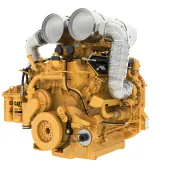A comprehensive line-up at Hillhead 2014 from Deutz

First UK display of company’s full engine range to meet EU Stage IV/US EPA Tier 4 Final exhaust emissions
DEUTZ consider Hillhead 2014 to be the ideal platform to showcase their latest engine technologies and will, therefore, be using the show to introduce their new generation of engines that meet EU Stage IV/US EPA Tier 4 Final emission levels.
The newly developed TCD 2.9 L4 engine features ultra-compact dimensions for installation in tight spaces. Externally cooled exhaust gas recirculation and a high-pressure common-rail system result in maximum performance with minimal emissions. The engine is said to set new standards in its class with a peak output of 55.4kW and torque of 300Nm.
The turbocharged straight four-cylinder TCD 3.6 L4 covers the range up to 90kW at emissions level EU Stage IIIB/US EPA Tier 4 Interim and develops maximum torque of 480Nm. At EU Stage IV/US EPA Tier 4 Final it attains maximum output of 97kW at maximum torque of 500Nm, elevating the four-cylinder power pack to a class that is normally served by engines of much greater displacement. The engine is also available without an intercooler at outputs below 56kW. Furthermore, the TCD 3.6 permits 100% power take-off both front and back and also features two auxiliary power take-offs with total torque of up to 310Nm.
For medium and heavy-duty applications, Deutz offer the straight four- and six-cylinder TCD 4.1 and TCD 6.1 engines. The TCD 4.1 covers the range up to 115kW, developing a maximum torque of 610Nm, whilst the TCD 6.1 is available at higher outputs up to 180kW and maximum torque of 1,000Nm.
The TCD 7.8 is Deutz’s most powerful mid-class engine. Its maximum output of 250kW and top torque of 1,400Nm advances this six-cylinder engine to a class that used to be dominated by 9-litre engines. It offers long service life, long service intervals and 3–5% lower fuel consumption compared with its Tier 3 predecessor.
The six-cylinder TCD 12.0 delivers maximum output of 390kW and maximum torque of 2,130Nm, whilst the eight-cylinder TCD 16.0 (pictured) rounds out the Deutz line-up with 520kW and top torque of 2,890Nm.
Supplementing the extensive engine line-up is Deutz’s modular DVERT system that is compatible with different engine configurations. DVERT provides an open DVERT Oxidation Catalyst (DOC) for the below 4-litre TCD 2.9 and TCD 3.6 engines, and can be mounted on the engine as an option. This simple and maintenance-free EAT design is said to be the best solution for applications currently below 90kW. For markets with stricter regulations a DVERT particle filter (DPF) is available. At levels above 56kW, the TCD 3.6 comes equipped with the DOC plus SCR system to conform to EU emission level Stage IV/US EPA Tier 4 Final. An optional DVERT particle filter (DPF) is also available in lieu of the DOC.
For EU emission level Stage IV/US EPA Tier 4 Final, the 4- to 8-litre TCD 4.1, 6.1 and 7.8 engines come equipped with a DVERT particle filter and SCR. This design is said to be the best solution for engines with medium and high energy density because it meets all the demands of larger devices in high-performance applications without compromising top performance, maximum torque and engine dynamics.
The TCD 12.0 and 16.0 engines conform to the latest emission levels with the SCR-only concept, which means two SCR systems are engaged in series. This DVERT design is the logical development of the DVERT SCR concept for these engines at EU Level IV/US EPA Tier 4 Final. The system makes it possible to dispense with exhaust-gas recirculation for these engines. The connections and the heat balance on the engines remain virtually unchanged, so complicated and costly modifications during engine installation become unnecessary.
An intelligent Heat Management System (HMS) for regulating exhaust gas temperature is employed in all Level IV engines greater than 56kW. Air in the intake manifold is throttled whilst internal improvements to the engine combine with sophisticated EAT regulation to ensure the high efficiency of the DVERT SCR system and regeneration of the DVERT particle filter under any operating condition.









